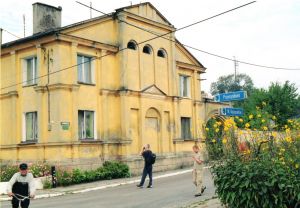Dabie

Dabie - Former Synagogue 2005
Dabie Nad Nerem is located on the Ner River about 10 miles to the southeast of Kolo. There was approximately 1,100 Jews in Dabie at the outbreak of the Second World War in September 1939. German forces occupied Dabie in mid-September 1939 and soon after their arrival, they insisted on removing Jews from the towns administration and ordered the Jews to present themselves for forced labour. By mid-October 1939, the German authorities had confiscated several Jewish owned businesses, appointing German trustees to run them. During the first weeks of the occupation, Jews were humiliated, being forced to perform gymnastics on the market square, and being rounded up for forced labour. In December 1939, Jews were ordered to wear yellow Star of David, and they were forbidden to walk on the pavements. The Germans ordered the establishment of a Jewish Council (Judenrat), in Dabie, and this was chaired by Josef Dyament. Other members of the Judenrat included, Lejb Strykowski, Pinkas Elbojm, Mosze Gostynski, Gerszon Engel and Chaim Elie Lewin. Initially, the Germans appointed a local ethnic German, named Nelter, as Mayor of the town, but within a few weeks he was replaced by another ethnic German named Woltmann. By 1940, a German from the Reich, named Fellenberg, had been appointed Mayor of Dabie.
In the spring of 1940, the Jewish community in Dabie applied for help from the American Jewish Joint Distribution Committee (AJDC), in Warsaw. However, an initial payment of 4,000 zloty was not received until May 1940, owing to the need to obtain approval from the German Currency Office. This money was used to distribute bread, flour, and sugar to more than 75 needy families, but further support from the AJDC was then interrupted, due to German objections. The aid committee, also headed by Josef Dyament, raised some money within the Jewish community in order to maintain welfare efforts. In September 1940 it opened a bakery, and profits from the bakery were used to provide bread to needy families, but in December 1940, the bakery was forced to close, owing to objections by the local ethnic German bakers. A further sum of 500 Reichmark was received from the AJDC in December 1940, which was used to aid 70 of the poorest families, but after this date, there was no further correspondence regarding welfare matters. The German authorities established a ghetto in Dabie, in the summer of 1940, on Kilinski Street. The ghetto contained approximately 1,100 Jews and it was very overcrowded. For example up to 10 people had to live in one house. It remained an open ghetto throughout its existence, but Jews were only allowed to leave the ghetto with a special pass. The synagogue and the Bet Midrash were converted into storage areas by the Germans. The inhabitants of the ghetto were employed in various craft shops in the town and also cleaned the towns streets and parks. At the end of the summer in 1941, about 200 Jews were deported to labour camps in the Poznan region. Most of those who survived these forced labour camps, were deported to Auschwitz concentration camp from the autumn of 1942. On hearing of the news on 9 December 1941, of the deportations from the nearby ghetto in Kolo, the Judenrat in Dabie, sent a man named Volkevitsh to Kolo, to try and find out what had happened to the Jews there.
The liquidation of the Dabie ghetto started on 14 December 1941- first Fellenberg, the Mayor, sent for Josef Dyament and informed him that the Jews were being sent out of the town. German police forces then rounded up the Jewish residents on the market square, approximately 1,000 people and concentrated them in the theatre and the church. Here they were beaten, and the rabbi was threatened with a revolver and forced to scream that the war was the fault of the Jews. On the next morning the Jews were released back to their homes, but soon afterwards the Mayor ordered 6 men to report for work. These men were sent to the Chelmno death camp, where they joined the grave digging detachment that worked in the Rzuchow forest. On 17 December 1941, the Jews were gathered again in the theatre and the church, and after being beaten and tormented, the next day on 18 December 1941, they were deported on trucks to Chelmno death camp, where they were murdered in the gas-vans. After the deportation, the belongings of the Jews were collected and stored in the church. A few Jewish survivors returned to Dabie after the war ended, but they did not stay, and no Jewish community lives in Dabie today.
Sources:
The Encyclopaedia of Camps and Ghettos 1933-1945, USHMM, Indianna University Press Bloomington and Indianapolis 2012 Chelmno Witnesses Speak, The Council For the Protection of Memory of Combat and Martydom, The District Museum in Konin, Konin , Lodz 2004Thanks to Andrzej Grzegorczyk – Chelmno Museum & Cameron Munro
Photograph – Chris Webb Archive
© Holocaust Historical Society 2014

